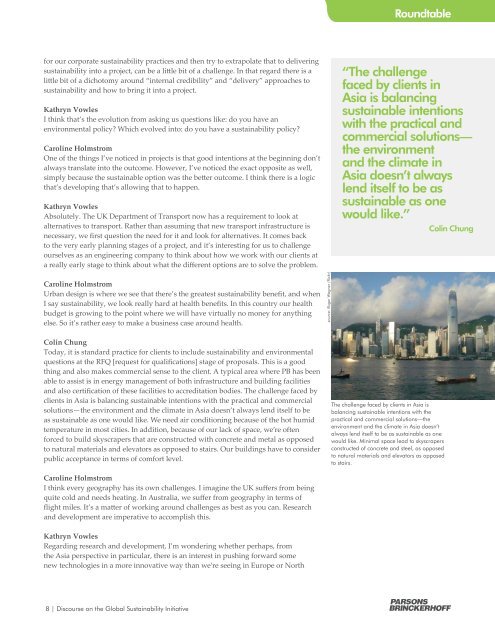June 2011 - Parsons Brinckerhoff
June 2011 - Parsons Brinckerhoff
June 2011 - Parsons Brinckerhoff
You also want an ePaper? Increase the reach of your titles
YUMPU automatically turns print PDFs into web optimized ePapers that Google loves.
Roundtable<br />
for our corporate sustainability practices and then try to extrapolate that to delivering<br />
sustainability into a project, can be a little bit of a challenge. In that regard there is a<br />
little bit of a dichotomy around “internal credibility” and “delivery” approaches to<br />
sustainability and how to bring it into a project.<br />
Kathryn Vowles<br />
I think that’s the evolution from asking us questions like: do you have an<br />
environmental policy? Which evolved into: do you have a sustainability policy?<br />
Caroline Holmstrom<br />
One of the things I’ve noticed in projects is that good intentions at the beginning don’t<br />
always translate into the outcome. However, I’ve noticed the exact opposite as well,<br />
simply because the sustainable option was the better outcome. I think there is a logic<br />
that’s developing that’s allowing that to happen.<br />
Kathryn Vowles<br />
Absolutely. The UK Department of Transport now has a requirement to look at<br />
alternatives to transport. Rather than assuming that new transport infrastructure is<br />
necessary, we first question the need for it and look for alternatives. It comes back<br />
to the very early planning stages of a project, and it’s interesting for us to challenge<br />
ourselves as an engineering company to think about how we work with our clients at<br />
a really early stage to think about what the different options are to solve the problem.<br />
“The challenge<br />
faced by clients in<br />
Asia is balancing<br />
sustainable intentions<br />
with the practical and<br />
commercial solutions—<br />
the environment<br />
and the climate in<br />
Asia doesn’t always<br />
lend itself to be as<br />
sustainable as one<br />
would like.”<br />
Colin Chung<br />
Caroline Holmstrom<br />
Urban design is where we see that there’s the greatest sustainability benefit, and when<br />
I say sustainability, we look really hard at health benefits. In this country our health<br />
budget is growing to the point where we will have virtually no money for anything<br />
else. So it’s rather easy to make a business case around health.<br />
source: Roger Wagner (flickr)<br />
Colin Chung<br />
Today, it is standard practice for clients to include sustainability and environmental<br />
questions at the RFQ [request for qualifications] stage of proposals. This is a good<br />
thing and also makes commercial sense to the client. A typical area where PB has been<br />
able to assist is in energy management of both infrastructure and building facilities<br />
and also certification of these facilities to accreditation bodies. The challenge faced by<br />
clients in Asia is balancing sustainable intentions with the practical and commercial<br />
solutions—the environment and the climate in Asia doesn’t always lend itself to be<br />
as sustainable as one would like. We need air conditioning because of the hot humid<br />
temperature in most cities. In addition, because of our lack of space, we’re often<br />
forced to build skyscrapers that are constructed with concrete and metal as opposed<br />
to natural materials and elevators as opposed to stairs. Our buildings have to consider<br />
public acceptance in terms of comfort level.<br />
The challenge faced by clients in Asia is<br />
balancing sustainable intentions with the<br />
practical and commercial solutions—the<br />
environment and the climate in Asia doesn’t<br />
always lend itself to be as sustainable as one<br />
would like. Minimal space lead to skyscrapers<br />
constructed of concrete and steel, as opposed<br />
to natural materials and elevators as opposed<br />
to stairs.<br />
Caroline Holmstrom<br />
I think every geography has its own challenges. I imagine the UK suffers from being<br />
quite cold and needs heating. In Australia, we suffer from geography in terms of<br />
flight miles. It’s a matter of working around challenges as best as you can. Research<br />
and development are imperative to accomplish this.<br />
Kathryn Vowles<br />
Regarding research and development, I’m wondering whether perhaps, from<br />
the Asia perspective in particular, there is an interest in pushing forward some<br />
new technologies in a more innovative way than we’re seeing in Europe or North<br />
8 | Discourse on the Global Sustainability Initiative
















